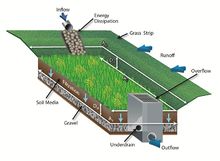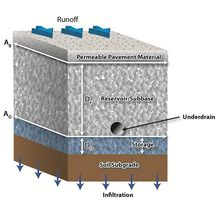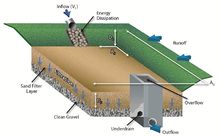
Difference between revisions of "Stormwater filtration Best Management Practices"
m |
m |
||
| Line 3: | Line 3: | ||
[[File:Sand filter credit article.jpg|thumb|220px|alt=schematic of sand filter|Schematic of a sand filter BMP.]] | [[File:Sand filter credit article.jpg|thumb|220px|alt=schematic of sand filter|Schematic of a sand filter BMP.]] | ||
| − | Filtration Best Management Practices (BMPs) treat urban stormwater runoff as it flows through a filtering medium, such as sand or an organic material. They are generally used on small drainage areas (5 acres or less) and are primarily designed for pollutant removal. | + | Filtration Best Management Practices (BMPs) treat urban stormwater runoff as it flows through a filtering medium, such as sand or an organic material. They are generally used on small drainage areas (5 acres or less) and are primarily designed for pollutant removal. They are effective at removing total suspended solids (TSS), particulate phosphorus, metals, and most organics. They are less effective for soluble pollutants such as dissolved phosphorus, chloride, and nitrate. Their effectiveness for bacteria varies with BMP. Link [http://stormwater.pca.state.mn.us/index.php/Information_on_pollutant_removal_by_BMPs here] for information on pollutant removal. Most filtration BMPs will achieve some volume reduction, depending on the BMP design. See information on credits for each BMP. |
| − | |||
| − | BMPs | ||
| − | |||
Revision as of 14:03, 30 April 2015
Filtration Best Management Practices (BMPs) treat urban stormwater runoff as it flows through a filtering medium, such as sand or an organic material. They are generally used on small drainage areas (5 acres or less) and are primarily designed for pollutant removal. They are effective at removing total suspended solids (TSS), particulate phosphorus, metals, and most organics. They are less effective for soluble pollutants such as dissolved phosphorus, chloride, and nitrate. Their effectiveness for bacteria varies with BMP. Link here for information on pollutant removal. Most filtration BMPs will achieve some volume reduction, depending on the BMP design. See information on credits for each BMP.
The following practices typically employ an underdrain, which captures most of the runoff that enters the BMP. For information on these BMPs with no underdrain, see Infiltration practices.
Other filtration BMPs, including pre-treatment practices
Manufactured devices


